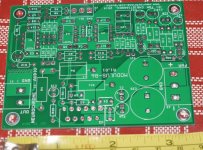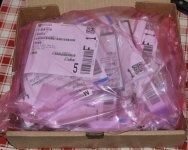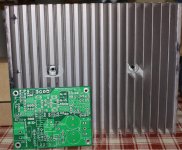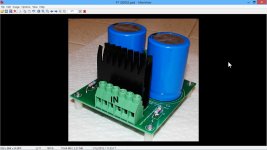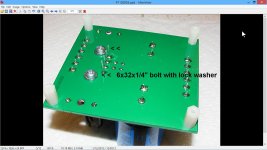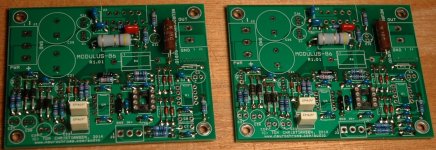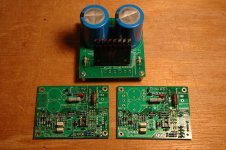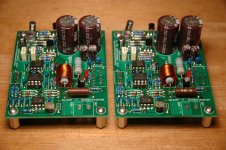Thought it might be interesting to start a thread on a build I am just starting. I'm converting my apogee Centaur Minors to open baffle with active amplification and needed 4 channels of the best I could afford of 20-40W per channel. After looking at a number of alternatives I decided to go with the Modulus-86 developed by TomChr, webpage here Modulus-86: Composite amplifier achieving 0.00018 % THD. and DIYaudio thread here Modulus-86: Composite amplifier achieving <0.0004 % THD+N. - diyAudio. My main reason for chosing this was the fact it provides some of the best measured performance I have ever seen from a power amp (comfortably lower distortion than my source or pre-amp), is unfussy about power supply, working to spec with a basic setup and has a balanced input that gives nearly 90dB CMRR even from single ended sources. Basically reference grade for pocket money and perfect for me as I want to play in other areas with my system at the moment.
A few people are thinking of building this so thought I would start a thread on my build and allow people to answer any questions that they have and share their builds.
What I am afraid I cannot do is offer comparisons with xyz. I've been out of DIY for 20 years and getting back in now so I don't have an array of different DIY boards. Also I am not going to claim that this sounds better than any other LM3886 based amp. It will however measure better, much better and certainly well below any sane levels at which transparency is defined. It should have no sound its own.
I'll take some initial pics and start soldering in the morning.
Disclaimer: I have no financial or other interest in the work Tom does. I'm just a customer.
A few people are thinking of building this so thought I would start a thread on my build and allow people to answer any questions that they have and share their builds.
What I am afraid I cannot do is offer comparisons with xyz. I've been out of DIY for 20 years and getting back in now so I don't have an array of different DIY boards. Also I am not going to claim that this sounds better than any other LM3886 based amp. It will however measure better, much better and certainly well below any sane levels at which transparency is defined. It should have no sound its own.
I'll take some initial pics and start soldering in the morning.
Disclaimer: I have no financial or other interest in the work Tom does. I'm just a customer.
Thanks for starting a build thread, Bill, and inviting others to pile on with our own builds. I have my boards and my parts from Tom's Mouser project link included in the kit instruction email. I'm ready to start building tomorrow. I also have Tom's power supply board and Mouser parts.
I need six low distortion amps for 3way active crossover speaker based on Jeff Bagby's Kairos.
I also bought a pair of Twisted Pear Sympatico, and I will compare them. I still need two more channels, or more if one of them doesn't work for me. bought the two different designs out of curiosity, and intending to offer my opinion about which I liked better overall. I've built Twisted Pear kits before.
In the past I have not enjoyed listening to LM4562 opamp, so I'm a little leery of both designs which use these, but Tom's subjective description of his amp's sound did not agree with my negative experiences so I figured what the hell. Then I find out he only built one channel and has not listened to it in stereo. A good engineer's confidence!
A good engineer's confidence!
So I'm looking forward to hearing them. I will compare the two different designs as stereo amps using the passive crossover of my 2way Kairos, and as individual amps in my 3 way setup with active crossover. I'll also probably built Tom's parallel 4870 board when available.
I have built only one amp before, a point to point perfboard current source LM3875 of a friend's else's design. This should be fun!!
Rich
I need six low distortion amps for 3way active crossover speaker based on Jeff Bagby's Kairos.
I also bought a pair of Twisted Pear Sympatico, and I will compare them. I still need two more channels, or more if one of them doesn't work for me. bought the two different designs out of curiosity, and intending to offer my opinion about which I liked better overall. I've built Twisted Pear kits before.
In the past I have not enjoyed listening to LM4562 opamp, so I'm a little leery of both designs which use these, but Tom's subjective description of his amp's sound did not agree with my negative experiences so I figured what the hell. Then I find out he only built one channel and has not listened to it in stereo.
So I'm looking forward to hearing them. I will compare the two different designs as stereo amps using the passive crossover of my 2way Kairos, and as individual amps in my 3 way setup with active crossover. I'll also probably built Tom's parallel 4870 board when available.
I have built only one amp before, a point to point perfboard current source LM3875 of a friend's else's design. This should be fun!!
Rich
Then I find out he only built one channel and has not listened to it in stereo.A good engineer's confidence!
Guilty as charged...
It helps if you start with a circuit that works well. So I start with measurements. If I can build a circuit that measures well, there is a very high probability that it will sound good as well. Once I have a solid circuit, I press on to the listening test. On my prototypes, I always start out listening in mono. There are two reasons for this: 1) cost (both in time and the additional parts needed for a stereo build). 2) I'm usually curious to hear how it sounds.
I actually find that I get very good correlation between the listening experience in mono and that in stereo. In the past, I have only been pleasantly surprised when building two channels and listening in stereo. Basically, if it sounds good in mono, it will sound amazing in stereo. The Modulus-86 sounded amazing to me in mono. I'm really curious to hear it in stereo!
For the mono test, I mix the left and right channel together and play the stereo signal through the mono amp. It's pretty interesting what one can learn from that.
Now, there are some tracks that are not suitable for mono reproduction. Pink Floyd, "Brain Damage" from Dark Side of the Moon is one of those. The "voices in the head" are actually recorded 180 º out of phase in the two channels, hence, they nearly cancel when the left and right channels are added. I'm sure that's not the effect Pink Floyd had in mind...
I do plan to build a stereo setup. That's the whole point of this here exercise... It just happened that work (you know, that day job thing that pays the bills) got super busy just as I launched the MOD86 and the MOD86 gained popularity faster than I had expected. I chose to prioritize customer requests and polishing the documentation over building an amp for myself.
Thanks to billshurv for starting a build thread. It's always good to see my circuits in action.
~Tom
Last edited:
Show and tell; excuse the table background. First pic shows the boards. Not the smallest 3886 PCBs out there, but pretty compact. And the box of components from Mouser. Never used the project ordering system before, but it's worked perfectly and all components are labelled by location to make it almost idiot proof. The heatsinks are £10 each off ebay. they need a clean up, but should be more than adequate for my needs.
Still not 100% on the rails to use. The heatsink is around the 0.5K/W mark, so with 2 boards mounted on it could run at +/-28V rails, but as the ribbon tweeter is 3.8Ohms current is king. I need to measure my incoming AC under a couple of situations then will decide on either 18 or 20v secondaries on the toroids. 18V is the current fave as that will give me +/-22V rails. if you look at figure 4 of the LM3886 spec sheet you will see that you benefit considerably in current capability at the limit dropping a few volts. Does that really matter? Unlikely, but as I am right at the limit of impedance that the chip is designed to drive it can't hurt.
Some my comment that my heatsinking is OTT on 22v rails. Possibly, but I know I will be able to add a 3rd board on each side if I need that as the speakers evolve with no worries on thermals.
Doing a sanity check on the power required, the speakers when new have their max output specified with 100W/4Ohms and recommend 150W/4Ohms. The crossover point (750Hz) means that around 40% of the music power is to the ribbon and the rest to the woofer. As I have a sub for the bottom octaves its nearer 30% to the woofer. So 40W/4Ohms into each is fine? In fact that's more than you need. When you go active the splitting of the spectrum gives you a doubling of effective power. so 2*25W/4Ohms into the active system will give me the same as 100W into the Passive version. I will be around 40W/4Ohms per channel, so considerable headroom. If I wasn't needing to add some boost to the bass to compensate for baffle losses I could drop to 20v rails no problem.
Still not 100% on the rails to use. The heatsink is around the 0.5K/W mark, so with 2 boards mounted on it could run at +/-28V rails, but as the ribbon tweeter is 3.8Ohms current is king. I need to measure my incoming AC under a couple of situations then will decide on either 18 or 20v secondaries on the toroids. 18V is the current fave as that will give me +/-22V rails. if you look at figure 4 of the LM3886 spec sheet you will see that you benefit considerably in current capability at the limit dropping a few volts. Does that really matter? Unlikely, but as I am right at the limit of impedance that the chip is designed to drive it can't hurt.
Some my comment that my heatsinking is OTT on 22v rails. Possibly, but I know I will be able to add a 3rd board on each side if I need that as the speakers evolve with no worries on thermals.
Doing a sanity check on the power required, the speakers when new have their max output specified with 100W/4Ohms and recommend 150W/4Ohms. The crossover point (750Hz) means that around 40% of the music power is to the ribbon and the rest to the woofer. As I have a sub for the bottom octaves its nearer 30% to the woofer. So 40W/4Ohms into each is fine? In fact that's more than you need. When you go active the splitting of the spectrum gives you a doubling of effective power. so 2*25W/4Ohms into the active system will give me the same as 100W into the Passive version. I will be around 40W/4Ohms per channel, so considerable headroom. If I wasn't needing to add some boost to the bass to compensate for baffle losses I could drop to 20v rails no problem.
Attachments
Modulus-86 Power Supply
Couple of photos of my assembled power supply.
Since both in and out connections are very similar, I marked a photo
of the side where the transformer connects to avoid possible confusion.
I had the hardware on hand & decided to attach the heat sink with bolts
& washers instead of solder. (Bottom view.jpg)
Some of the leads haven't been trimmed in the photo.
jb74
Couple of photos of my assembled power supply.
Since both in and out connections are very similar, I marked a photo
of the side where the transformer connects to avoid possible confusion.
I had the hardware on hand & decided to attach the heat sink with bolts
& washers instead of solder. (Bottom view.jpg)
Some of the leads haven't been trimmed in the photo.
jb74
Attachments
The bushings really put your soldering iron to the test...
~Tom
Is that a challenge? Always wanted to see what a metcal could really do
My STSS is a lot older, but should do it. I spent years hunting a good deal on a metcal as I missed out on all the ones when they shut the nokia production line down. It covers up for my poor soldering skills (I used to work with satellites and the guys there really could solder. No second chances in space!).
Now lead or lead free solder... Martin Colloms is convinced lead free sounds worse...</windup>
Now lead or lead free solder... Martin Colloms is convinced lead free sounds worse...</windup>
Nothing more fun than slingin some hot solder on a cold winter's day!
My Power86 is done, the Mod-86s are 2/3s done.
Some ideas I thought of so far:
1. Add "C22 and C26" to the customer part number on the Mod-86 Mouser project list so it gets printed on the part envelope (0.1uF ceramic.)
2. Maybe put a project name or prefix in the cust part# to help with sorting the parts when different projects are ordered together in one big box.
3. The TDK caps' tolerance isn't great. C15, nominal 150pF, parts were actually 214pF. C10, nominal 100pF, parts 164pF. Other TDKs similar, but they are pretty!
My Power86 is done, the Mod-86s are 2/3s done.
Some ideas I thought of so far:
1. Add "C22 and C26" to the customer part number on the Mod-86 Mouser project list so it gets printed on the part envelope (0.1uF ceramic.)
2. Maybe put a project name or prefix in the cust part# to help with sorting the parts when different projects are ordered together in one big box.
3. The TDK caps' tolerance isn't great. C15, nominal 150pF, parts were actually 214pF. C10, nominal 100pF, parts 164pF. Other TDKs similar, but they are pretty!
Attachments
1. Add "C22 and C26" to the customer part number on the Mod-86 Mouser project list so it gets printed on the part envelope (0.1uF ceramic.)
2. Maybe put a project name or prefix in the cust part# to help with sorting the parts when different projects are ordered together in one big box.
Sadly, Mouser limits the length of the customer part number field, so "C22, C26" won't fit... Most people seem to figure it out anyway. I may define a customer part number and maintain a BOM with component designators versus customer part numbers.
It would be cool with a project name on the bag as well. However Mouser limits the length of the field.
I have emailed them asking for alternate options. They don't have any at the moment, but will take my suggestions into consideration. I did ask about including the project name as well.
3. The TDK caps' tolerance isn't great. C15, nominal 150pF, parts were actually 214pF. C10, nominal 100pF, parts 164pF. Other TDKs similar, but they are pretty!
You may want to check the calibration of your capacitance meter. Usually there's a knob that you need to turn to calibrate out the test lead capacitance when measuring small capacitances. The caps are ±5 % tolerance as I recall. TDK is a reliable manufacturer and I expect their parts to meet the published specs in the data sheet.
Nice work so far, though. It's fun to see my builders' boards come together.
~Tom
Nothing more fun than slingin some hot solder on a cold winter's day!
My Power86 is done, the Mod-86s are 2/3s done.
Doing well. I have not managed a single joint this week due to the day job getting in the way
Doing well. I have not managed a single joint this week due to the day job getting in the way
Just say no to work... (Yeah, doesn't work for me either). Work is a gateway drug, I swear...
All Tom's fault of course
Of course. How could it be any other way...
Thanks for posting your experiences. I really enjoy reading about your builds. If you have any suggestions on how to further improve the build experience, just shoot me an email.
~Tom
Almost finished the amps today. Last remaining step is soldering the 3886 after the box is built. Next up is the box, then IC cables.
The Modulus-86s took about 6 hours to build both boards. The Sympaticos went together in about half hour because much of it is SMD, presoldered to PCB.
The Modulus-86s took about 6 hours to build both boards. The Sympaticos went together in about half hour because much of it is SMD, presoldered to PCB.
Attachments
Richidoo,
Looking good.
What have you selected for the box?
Thanks zman
I already have big heatsinks so I'll diy the box with wood and aluminum sheet to fit the heatsinks. Not designed it yet.
Eventually I'll need two boxes with 3ch amps in each one, for active crossover speakers. For now I'll make stereo amps to audition the amps with passive crossovers.
- Home
- Amplifiers
- Chip Amps
- Modulus-86 build thread
